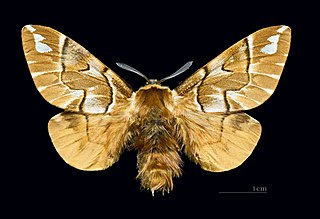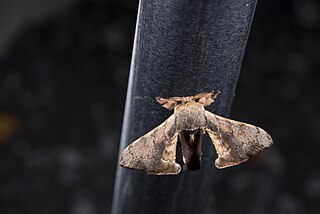
Endromidae is a family of moths. It was long considered to be a monotypic family, containing just one species, the Kentish glory, Endromis versicolora, found throughout the Palaearctic region. The family now consists of several genera and about 30 species, all former members of the family Bombycidae.

The Bombycidae are a family of moths known as silkworm moths. The best-known species is Bombyx mori (Linnaeus), or domestic silk moth, native to northern China and domesticated for millennia. Another well-known species is Bombyx mandarina, also native to Asia.

Apatelodidae, the American silkworm moths, is a family of insects in the order Lepidoptera. They are a family within the superfamily Bombycoidea, though they have in the past been considered a subfamily of Bombycidae.

Phiditiidae is a family of moths. The family used to be placed as a subfamily (Phiditiinae) in the family Bombycidae.

Quentalia is a genus of moths of the family Bombycidae first described by William Schaus in 1929. It has at times been placed in the family Apatelodidae, but recent research indicates the subfamily Epiinae, to which Quentalia belongs, is affiliated with Bombycidae.
Dalailama is a genus of moths of the family Endromidae, previously placed in the subfamily Oberthueriinae of the family Bombycidae.
Gunda engonata is a species of moth from the Bombycidae family. It was described by Charles Swinhoe in 1899. It is found in India.

Gunda proxima is a species of moth in the family Bombycidae. It was described by Roepke in 1924. It is found in Asia, including Indonesia and Vietnam.

Ernolatia moorei is a moth in the family Bombycidae first described by Thomas Hutton in 1865. It is found in Sri Lanka, India, southern China, Borneo and Taiwan.

Trilocha varians, the Greenish silk-moth is a moth in the family Bombycidae described by Francis Walker in 1855. It is widespread in the Oriental region from India, Sri Lanka, China, extending to Taiwan, the Philippines, Pakistan, Sulawesi and Java.
Bivincula watsoni is a moth in the family Bombycidae. It was described by Wolfgang Dierl in 1978. It is found in Sikkim, India.
Penicillifera lactea is a moth in the family Bombycidae. It is found from eastern Afghanistan to India (Assam).
Ocinara bifurcula is a moth in the family Bombycidae. It was described by Wolfgang Dierl in 1978. It is found on Sumatra, Peninsular Malaysia and Borneo. The habitat generally consists of lowland areas, but it has been recorded as high as 1,500 meters.
Ocinara dilectula is a moth in the family Bombycidae. It was described by Francis Walker in 1856. It is found on Java and possibly Sumatra.
Ocinara ficicola is a moth in the family Bombycidae. It was described by Eleanor Anne Ormerod in 1889. It is found in the Democratic Republic of the Congo, Eritrea, Kenya, Nigeria, Somalia, South Africa and Uganda.
Racinoa leucoides is a moth in the Bombycidae family. It was described by Strand in 1910. It is found in Tanzania.
Ocinara polia is a moth in the family Bombycidae. It was described by Willie Horace Thomas Tams in 1935. It is found on Sulawesi.







